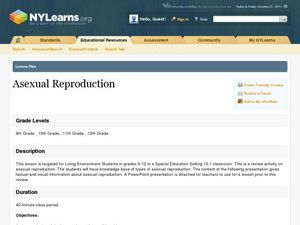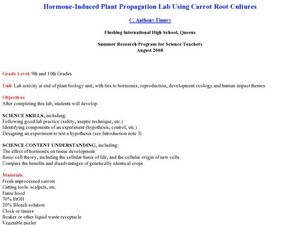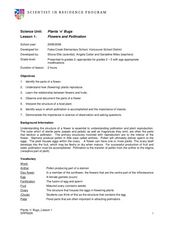Curated OER
Asexual Reproduction
Sixth graders investigate how asexual reproduction produces single-parent offspring. They use plants and yeast to demonstrate vegetative propagation and budding in a laboratory. Students draw five different types of asexual reproduction.
Curated OER
PLANT PARTS WE EAT
Students identify an assortment of vegetables and learn how to locate the parts humans use for food. Students identify the plant parts we eat. Students color the pictures on their worksheets as provided. Students match the plants to the...
Curated OER
Plant And Animal Adaptations
Students examine plant and animal life while looking at the environments the organismisms live in. They determine how form follows function by looking an aquatic turtle and noticing its feature of adaptation features. They work in groups...
Curated OER
Survey of the Plant Kingdom
For this plant kingdom worksheet, students will review the characteristics of the 12 divisions of the plant kingdom, comparing and contrasting their structures and life cycles. This worksheet has 17 matching, 5 short answer, and 5 fill...
Curated OER
Reproduction
In this reproduction activity, high schoolers review the processes involved with sexual reproduction in animals and pollination in plants. This activity has 6 fill in the blank, 5 true or false, and 9 short answer questions.
Curated OER
Plant Pollution
Students study the different parts of a flower and their functions. For this pollination lesson students study a flower under a microscope.
Curated OER
Flowering Phenology: How Do Plants Know When To Flower?
Students explore the biotic and abiotic factors that affect plant reproduction and the potential consequences of human activities on plant populations. The effects of urbanization are discussed as an influence in the consequences.
Curated OER
Flower Powder
Students collect and observe pollen. In this plant reproduction biology lesson, students use pollen boards to collect pollen from flowers, then match it with the correct paper flowers. Students move artificial bees from flower to flower...
Curated OER
Two Beets Or Not Two Beets—What Is Your Question?
Students use the scientific method to test an idea regarding the structures of a plant as it supports the biological evidence for life. In this growing roots lesson plan, students use organizing sheets to record their findings. Students...
Curated OER
Pollinators and Wildflowers
Learners explore how plants depend on pollinators to reproduce. In this pollination lesson students dissect a local flower and collect and identify pollinating insects.
Curated OER
Cell Structures and Their Functions
Life science learners investigate live cells. They examine wet mount slides of cyanobacteria and Elodea plants. They peer into the dynamic microscopic world of protists. Afterward, they construct a model of a cell, including rudimentary...
Curated OER
Hormone-Induced Plant Propagation Lab using Carrot Root Cultures
Learners evaluate the importance of hormones in living things. In this biology lesson, students experiment on carrots to differentiate how humans and plants reproduce. They collect data from experiment to answer analysis questions.
Curated OER
Flower Power
Students explore the parts of flowers and how they reproduce. They dissect flowers and observe the reproductive organs. Students observe anthers and ovaries of Tiger Lilies under a microscope. They investigate how insects and other...
Curated OER
Recognition and Classification of Mixtures
Immerse your chemistry class in solutions! They melt and compare the mixtures that make up margarine, separate black ink into its component colors, distill ocean saltwater, and practice chromatography with plant pigments. There are eight...
Curated OER
Evolution and the Fossil Record
Engage young biologists with four laboratory activities that explore the fossil record. Learners examine fossil images, a fossil kit, the rock record, and geologic time scale. They even experiment with the oxygen production of an Elodea...
Consortium for Ocean Science Exploration and Engagement (COSEE)
Arctic Smorgasbord
Though the walrus spends roughly one third of its time on land, it eats organisms that live on the bottom of the ocean. The first in a series of five, the lesson uses a variety of plant and animal cards to have scholars build an arctic...
Curated OER
Flowering Phenology: How Do Plants Know When to Flower?
Students study the process of plant reproduction and the biotic and abiotic factors that affect flowering phenology. In this plant reproduction lesson plan, students describe the interaction of environmental factors as it relates to...
Curated OER
Flowers and Pollination
Young scholars explore the environment by researching plant reproduction. In this pollination instructional activity, students define botany related vocabulary terms such as disc flower, petal and fertilization. Young scholars dissect a...
Curated OER
Pollination-Plants and Flowers Lesson Plan
Young scholars study the reproductive parts and pollination for a flower. In this pollination lesson plan, students dissect flowers to perform an investigation. Young scholars also use tube socks to show how pollination works. A...
Curated OER
Seed Germination
Students germinate a Mung Bean seed. In this seed instructional activity students conduct an experiment germinating a Mung Bean. They apply three different treatments to the seeds: dry, moist, and underwater incubation.
Curated OER
Lesson 2: the Cell Cycle
Learners explain how cells reproduce. In this biology instructional activity, students explain the different stages of the cell cycle. They calculate the number of new cells produced.
Garden Earth Naturalist Club
Parts of a Flower! Flower Dissection
Sometimes the best way to learn about plants is to see the different parts of a plant yourself. Groups of learners dissect flowers to answer questions about what they observe and what they wonder about their flower.
Curated OER
Variations in Living Things
Biology beginners observe traits in a collection of plant parts to realize the tremendous amount of genetic variation within a species. They consider rules of nature and discuss what would happen if they changed. They also examine data...
Curated OER
Life Cycles
Students explore the life cycle of living things through the eight lessons of this unit. The butterfly, frog, chicken, and plant are inspected and form the basis of the work done in this unit.
Other popular searches
- Flowering Plant Reproduction
- Seedless Plant Reproduction
- Asexual Plant Reproduction
- Plant Reproduction Lab
- Plant Reproduction by Seeds
- Plant Reproduction Video
- Types of Plant Reproduction
- Plant Reproduction Parts
- Plant Reproduction Puzzles
- Plant Reproduction Do Now
- Sexual Plant Reproduction
- Plant Reproduction by Spores

























